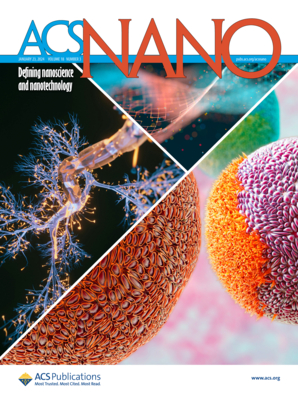A Self-Assembled Nanovaccine with BA.4/5 Receptor-Binding Domain and CpG Oligodeoxynucleotides Induces Broad-Spectrum Neutralization against SARS-CoV-2 Omicron Subvariants
IF 15.8
1区 材料科学
Q1 CHEMISTRY, MULTIDISCIPLINARY
引用次数: 0
Abstract
Over the past 3 years, SARS-CoV-2 Omicron has been circulating globally with the emergence of multiple subvariants, including BA.5, BA.5.2, XBB, XBB.1, EG.5.1, HK.3, BA.2.86, JN.1, and KP.2. To combat these Omicron subvariants, several vaccines based on receptor-binding domain (RBD) dimers have been developed; however, RBD dimer vaccines require frequent updates to cope with the emergence of new variants. In contrast, the development of a safe, effective, and broad-spectrum vaccine against multiple Omicron subvariants, including the latest JN.1 and KP.2, would be a one-size-fits-all solution. Here, we designed BA.4/5 RBD-PC7A conjugate micelles by displaying the BA.4/5 RBD in PC7A micelles. Remarkably, the micelles elicited potent neutralizing antibodies (NAbs) in rabbits, effectively neutralizing BA.5.2, XBB.1.18, and HK.3 infections. Moreover, the micelles alone were able to induce NAbs in mice against the BA.5 variant. When a cytosine-phosphate-guanine (CpG) adjuvant was added and electrostatically adsorbed to the micelles, there was a significant increase in the antibody titers of IgG1, IgG2b, and IgG2c. This enhancement facilitated the broad neutralization of various strains, including BA.5.2, XBB.1.18, HK.3, JN.1, and KP.2. Furthermore, the micelles adsorbed with CpG protected golden hamsters from infection with the BA.5.2 strain. This study presents a potent and broadly neutralizing nanovaccine that includes the BA.4/5 RBD antigen and a CpG adjuvant. It demonstrates efficacy against multiple Omicron subvariants, including BA.5, BA.5.2, XBB.1.18, HK.3, JN.1, and KP.2, highlighting its potential for clinical translation.

求助全文
约1分钟内获得全文
求助全文
来源期刊

ACS Nano
工程技术-材料科学:综合
CiteScore
26.00
自引率
4.10%
发文量
1627
审稿时长
1.7 months
期刊介绍:
ACS Nano, published monthly, serves as an international forum for comprehensive articles on nanoscience and nanotechnology research at the intersections of chemistry, biology, materials science, physics, and engineering. The journal fosters communication among scientists in these communities, facilitating collaboration, new research opportunities, and advancements through discoveries. ACS Nano covers synthesis, assembly, characterization, theory, and simulation of nanostructures, nanobiotechnology, nanofabrication, methods and tools for nanoscience and nanotechnology, and self- and directed-assembly. Alongside original research articles, it offers thorough reviews, perspectives on cutting-edge research, and discussions envisioning the future of nanoscience and nanotechnology.
 求助内容:
求助内容: 应助结果提醒方式:
应助结果提醒方式:


